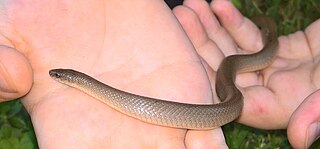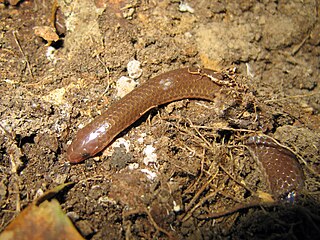
Bogertophis is a genus of New World rat snakes in the family Colubridae. The genus is endemic to the southwestern United States and northern Mexico. There are two accepted species.

Tropidoclonion is a genus of snake in the subfamily Natricinae of the family Colubridae. The genus is monotypic, containing the sole species Tropidoclonion lineatum, commonly known as the lined snake. The species is endemic to North America.

Nerodia is a genus of nonvenomous colubrid snakes commonly referred to as water snakes due to their aquatic behavior. The genus includes nine species, all native to North America.
The night snake is a species of rear-fanged colubrid. It is found in Mexico.

Thamnophis saurita, also known as the eastern ribbon snake, common ribbon snake, or simply ribbon snake, is a common species of garter snake native to Eastern North America. It is a non-venomous species of snake in the subfamily Natricinae of the family Colubridae. The ribbon snake averages 16 to 35 inches in total length. It is dark brown with bright yellow stripes. The ribbon snake is not sexually dimorphic; however, females are normally thicker than their male counterparts.

Ficimia streckeri, also commonly known as the Mexican hooknose snake, the Tamaulipan hooknose snake, and the Texas hook-nosed snake, is a small species of snake in the family Colubridae. The species is native to northeastern Mexico and adjacent southern Texas.

The Texas lined snake is a subspecies of nonvenomous snake in the subfamily Natricinae of the family Colubridae. The subspecies is endemic to the United States.

The smooth earth snake is a species of nonvenomous natricine colubrid snake native to the eastern half of the United States.

Haldea striatula, commonly called the rough earth snake, is a species of nonvenomous natricine colubrid snake native to the Southeastern United States.
The Brazos water snake, also called commonly Harter's water snake, is a species of mostly aquatic, nonvenomous snake in the family Colubridae. The species is endemic to Texas in the United States.

Storeria dekayi, commonly known as De Kay's brown snake, De Kay's snake, and simply the brown snake, is a small non-venomous species of snake in the family Colubridae. The species is native to North America and Central America.

The crayfish snake, also known commonly as the glossy crayfish snake, the glossy swampsnake, the glossy water snake, and the striped water snake, is a species of semiaquatic snake in the subfamily Natricinae of the family Colubridae. The species is endemic to the southeastern United States, and preys mainly on crayfish.

The Texas brown snake(Storeria dekayi texana), a subspecies of Storeria dekayi, is a nonvenomous snake in the family Colubridae. It is endemic to North America.

The northern redbelly snake is a nonvenomous snake in the family Colubridae, a subspecies of Storeria occipitomaculata. It is sometimes referred to as a fire snake. It is endemic, North America and The Caribbean in some parts in Jamaica, and Saskatchewan to Nova Scotia in the north and south to Florida and Texas.

Storeria occipitomaculata, commonly known as the redbelly snake or the red-bellied snake, is a species of snake endemic to North America.
Storeria hidalgoensis, commonly known as the Mexican yellow-bellied brown snake or the Mexican yellowbelly brown snake, is a nonvenomous snake in the family Colubridae. It is endemic to the Sierra Madre Oriental of Mexico.

Carphophis amoenus, commonly known as the worm snake, is a species of nonvenomous colubrid snake endemic to the eastern United States. C. amoenus can be found east of the Mississippi, from southwest Massachusetts south to southern Alabama west to Louisiana and then north to Illinois. This species of snake protects a large range, and normally prefers a moist habitat in the rocky woodlands, under rotten wood of logs and stumps. Though this snake is quite abundant over its range, it is rarely seen because of its dormant lifestyle and where it usually resides. This snake is most common on the edges or in the ecotonal areas of open to thick woodlands, and the borders of wetlands. It may also be found in the grasslands next to woodlands. The best chance to spot it is after heavy rains, when its small size and distinct color make it easy to spot. This species prefers moist soil inhabited by earthworms, which are its main prey, so the soil needs to be sufficiently moist. The snake's skin naturally evaporates water; so the soil needs to be moist enough to offset this. C. amoenus is mostly found under rocks and in sufficient leaf litter during the extreme daytime heat.




















